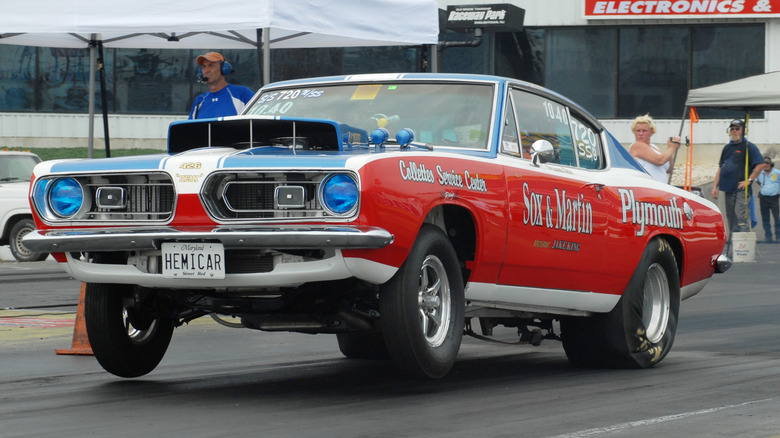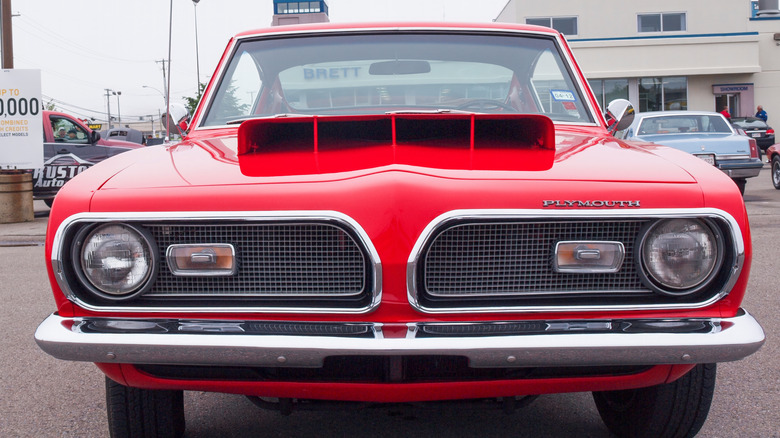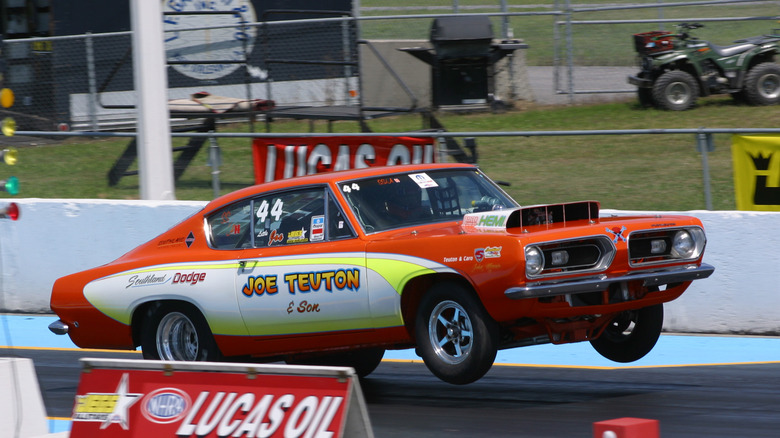This Limited-Run Barracuda Packed One Of The Rarest Engines Of All Time
Surprisingly, the Plymouth Barracuda beat the Ford Mustang to the ponycar market by a few weeks back in 1964. Unfortunately, the first-generation Barracuda of 1964-66 was little more than a Plymouth Valiant with a fastback roof grafted on, limiting its market appeal.
When the second-gen Barracuda appeared for the 1967 model year, it had greatly improved styling and came as a notchback coupe, fastback, or convertible. It became the best-selling generation of the Barracuda, a few years before emissions regulations and high insurance premiums conspired to kill off the muscle cars.
To boost the Barracuda's performance cred, the decision was made to go drag racing in the Super Stock classes of the National Hot Rod Association and American Hot Rod Association. It would pack a full-race version of Chrysler's HEMI engine in its smaller, lighter body. This was not the street version of the HEMI available in other Chrysler Corp. vehicles and was designated solely for drag racing. This is why the HEMI Barracuda's engine is so rare.
The next step was to send the Barracudas, along with some Dodge Darts that would also receive the HEMI treatment, to Hurst Performance, where the conversions would take place. The dealers were notified that these limited-edition, special-purpose, not for passenger use vehicles could be ordered. The HEMI Barracudas were available only in the fastback body style, using Body Code BO29 and the transmission code for either a four-speed manual (393) or a three-speed automatic transmission (395). The HEMI Barracuda was a complete package, and only 72 would be produced.
What came in the HEMI Barracuda package?
The HEMI Barracuda package included everything you would need to successfully campaign your car in a drag racing competition. The 426 cubic-inch (7.0-liter) HEMI engine was equipped with dual four-barrel Holley carburetors, a 12.5:1 compression ratio, cross ram intake manifold, Hooker competition headers with exhaust pipes and mufflers, and much more. There was also a heavy-duty rear axle, Sure-Grip differential, offset 15″ rear wheels, and front disc brakes.
The HEMI Barracuda's body featured fiberglass front fenders, a fiberglass hood with scoop, lightweight doors, a lightweight front bumper, and lightweight glass. Inside, the car was fitted with two bucket seats, while the rear seat was completely removed. All of this was done to reduce the HEMI Barracuda's weight and enable faster acceleration at the strip.
Along with all these additions to boost the HEMI Barracuda's performance, some items were left out for the same purpose. Deleted from the build sheet were items such as the outside mirrors, the heater, body sealer, sound deadening materials, the right side seat belt and body color paint. That's right, the HEMI Barracuda was delivered to the dealer wearing only its primer, with the fiberglass parts dressed only in gel coat. This was a serious race car for serious racers and qualifies as one of the most powerful Plymouth cars ever made.
Did the 1967-69 HEMI Barracuda dominate the competition?
The HEMI Barracuda of 1967-69 piled up quite a drag racing record. The first of the HEMI Barracudas went to Sox & Martin, the top Plymouth racing team. This stellar team consisted of driver Ronnie Sox, marketing and business wizard Buddy Martin, and engine builder Jake King.
Thanks to their combined efforts, the Sox & Martin HEMI Barracuda dominated the 1968 and 1969 seasons and posted many wins, with the AHRA naming Sox Driver of the Year in 1968. Sox & Martin's winning streak extended to seven of the nine major events the team entered in 1969. That year, titles from the NHRA, IHRA (International Hot Rod Association), and AHRA were won. The second-generation HEMI Barracuda proved to be unbeatable at the time, making it one of the coolest classic muscle cars with big block engines.
Current values for second-generation HEMI Barracudas on Classic.com can be hard to find, due to their rarity. The most recent was a Sox & Martin car, sold in 2023 for $258,500. This is likely a high point for a HEMI Barracuda of this vintage, considering its outstanding racing heritage.
According to research done by Dodge Garage, most of the HEMI Barracudas currently involved in drag racing competition are not the original cars, but have been built from stock Barracuda bodies. This is because the originals are simply too valuable to risk damaging on the drag strip.


